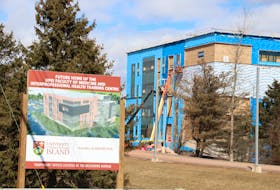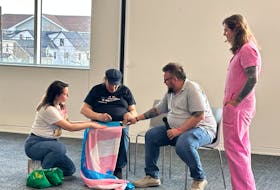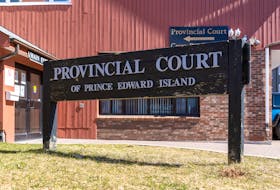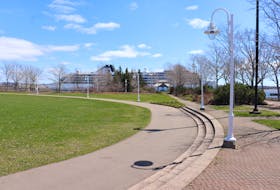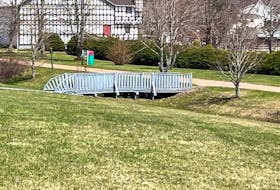The moral being that people are drawn to this place, that there’s something about it that keeps bringing them back, despite themselves.
It’s a romantic notion, but it’s surprisingly true in the case of Samuel Holland’s clock.
An Islander it may not be, but the Holland astronomical clock is still drawn here, again and again.
“It’s an amazing story. And the more you get into it, there’s simply so much history,” said George Dalton, a Summerside historian and one of many descendants of Samuel Holland, Canada’s first Surveyor General.
“I often think, if one could follow that clock, where it went, you’d meet a heck of a lot of people.”
Dalton gave a talk on the history of the clock at the Eptek Centre Thursday evening as part of an ongoing lecture series taking place across P.E.I. this year. The series is celebrating the 250th anniversary of Holland’s historic survey of P.E.I.
Archivist Fred Horne also gave a presentation on some of the maps in the MacNaught History Centre and Archives collection.
Holland’s 290-year-old timepiece was built in England in 1725 and was used in his work as he travelled and mapped British North America. It was eventually moved to the Holland home near Tryon and was passed through his family for several generations before being moved off Island. It is currently housed in the Canadian Museum of History in Gatineau, Que.
The story of the clock is timely because it is returning once again to the province to be part of an upcoming exhibition at the Confederation Centre of the Arts in Charlottetown of Holland artifacts. It will be on display from July 4 until Dec. 31.
“Samuel Holland put us on the map, so now we’re going to put him on the map,” said Dalton.
Kathy Stuart, of Meadowbank, drove to Summerside for the talk.
“I have a particular interest in that period of history. It’s all just very interesting to me, to think about our pre-Confederation history,” said Stuart.
The story of Holland’s clock was worth the drive, she added.
“It’s brilliant. It’s iconic in the way it connects with so many different things about Holland and P.E.I.”
To learn more about Holland or the activities being held to celebrate him this year, go online to www.samuelholland250pei.ca.
@JournalPMacLean
Journey of the clock:
– 1725: Built by George Graham in London, England, out of two types of mahogany, steel and brass.
– 1764: Arrives in Quebec aboard Holland’s Ship, HMS Canceaux.
– 1764: Arrives on P.E.I. for the first time at Fort Amherst where Holland bases himself during his survey of P.E.I.
– 1765: Moves to Louisbourg, N. S., while Holland surveys Cape Breton.
– 1766: Returns to Quebec City.
– 1770: HMS Canceaux, Holland and the clock travel to New England to survey the American colonies.
– 1775: Holland flees the American Revolutionary War and settles in Quebec City.
– 1801: Holland dies, is buried in Quebec and his widow moves to Charlottetown.
– 1805: His widow moves to her husband’s land holdings in Tryon.
– 1820s: Holland descendants move the clock to St. Eleanors.
– 1949: The clock is bequeathed to a relative in Wilcox, California.
– 1963: Clock sold to American Airlines, to use as a symbol to celebrate its 25 anniversary.
– 1965: George Leard, of Souris, petitions to repatriate the clock.
– 1966: It returns to Canada.
– 1967: It is part of the Maritime pavilion of Expo 67 and then moved to the Canadian Museum of Civilization.
– 1970: Loaned back to Charlottetown for the Canadian Museums Conference.
– 2000: Loaned to the Eptek Centre in Summerside for the city’s millennium celebrations
– 2015: Loaned back to P.E.I. for the 250th anniversary of Holland’s survey of P.E.I.
Biography of Samuel Holland:
Born in the Netherlands, in 1728, Samuel Holland lost his parents at a young age and was raised by two aunts.
As a young man, Holland enlisted in the Dutch artillery and served in the War of Austrian Succession.
Immigrated to England and served in the British navy, seeing battle during Seven Years War and helping lay siege to Louisburg.
Continued to serve in military capacity in the Americas until 1764 when his proposal to survey British North America was approved by the Crown.
Between 1764 and 1765 Holland surveyed P.E.I., dividing the Island into lots, parishes, counties and shire towns.
Continued his survey work until 1783 when he moved to Quebec City and became Surveyor General of Canada.
He died in 1801.
The moral being that people are drawn to this place, that there’s something about it that keeps bringing them back, despite themselves.
It’s a romantic notion, but it’s surprisingly true in the case of Samuel Holland’s clock.
An Islander it may not be, but the Holland astronomical clock is still drawn here, again and again.
“It’s an amazing story. And the more you get into it, there’s simply so much history,” said George Dalton, a Summerside historian and one of many descendants of Samuel Holland, Canada’s first Surveyor General.
“I often think, if one could follow that clock, where it went, you’d meet a heck of a lot of people.”
Dalton gave a talk on the history of the clock at the Eptek Centre Thursday evening as part of an ongoing lecture series taking place across P.E.I. this year. The series is celebrating the 250th anniversary of Holland’s historic survey of P.E.I.
Archivist Fred Horne also gave a presentation on some of the maps in the MacNaught History Centre and Archives collection.
Holland’s 290-year-old timepiece was built in England in 1725 and was used in his work as he travelled and mapped British North America. It was eventually moved to the Holland home near Tryon and was passed through his family for several generations before being moved off Island. It is currently housed in the Canadian Museum of History in Gatineau, Que.
The story of the clock is timely because it is returning once again to the province to be part of an upcoming exhibition at the Confederation Centre of the Arts in Charlottetown of Holland artifacts. It will be on display from July 4 until Dec. 31.
“Samuel Holland put us on the map, so now we’re going to put him on the map,” said Dalton.
Kathy Stuart, of Meadowbank, drove to Summerside for the talk.
“I have a particular interest in that period of history. It’s all just very interesting to me, to think about our pre-Confederation history,” said Stuart.
The story of Holland’s clock was worth the drive, she added.
“It’s brilliant. It’s iconic in the way it connects with so many different things about Holland and P.E.I.”
To learn more about Holland or the activities being held to celebrate him this year, go online to www.samuelholland250pei.ca.
@JournalPMacLean
Journey of the clock:
– 1725: Built by George Graham in London, England, out of two types of mahogany, steel and brass.
– 1764: Arrives in Quebec aboard Holland’s Ship, HMS Canceaux.
– 1764: Arrives on P.E.I. for the first time at Fort Amherst where Holland bases himself during his survey of P.E.I.
– 1765: Moves to Louisbourg, N. S., while Holland surveys Cape Breton.
– 1766: Returns to Quebec City.
– 1770: HMS Canceaux, Holland and the clock travel to New England to survey the American colonies.
– 1775: Holland flees the American Revolutionary War and settles in Quebec City.
– 1801: Holland dies, is buried in Quebec and his widow moves to Charlottetown.
– 1805: His widow moves to her husband’s land holdings in Tryon.
– 1820s: Holland descendants move the clock to St. Eleanors.
– 1949: The clock is bequeathed to a relative in Wilcox, California.
– 1963: Clock sold to American Airlines, to use as a symbol to celebrate its 25 anniversary.
– 1965: George Leard, of Souris, petitions to repatriate the clock.
– 1966: It returns to Canada.
– 1967: It is part of the Maritime pavilion of Expo 67 and then moved to the Canadian Museum of Civilization.
– 1970: Loaned back to Charlottetown for the Canadian Museums Conference.
– 2000: Loaned to the Eptek Centre in Summerside for the city’s millennium celebrations
– 2015: Loaned back to P.E.I. for the 250th anniversary of Holland’s survey of P.E.I.
Biography of Samuel Holland:
Born in the Netherlands, in 1728, Samuel Holland lost his parents at a young age and was raised by two aunts.
As a young man, Holland enlisted in the Dutch artillery and served in the War of Austrian Succession.
Immigrated to England and served in the British navy, seeing battle during Seven Years War and helping lay siege to Louisburg.
Continued to serve in military capacity in the Americas until 1764 when his proposal to survey British North America was approved by the Crown.
Between 1764 and 1765 Holland surveyed P.E.I., dividing the Island into lots, parishes, counties and shire towns.
Continued his survey work until 1783 when he moved to Quebec City and became Surveyor General of Canada.
He died in 1801.

